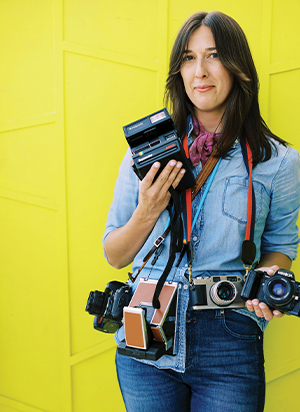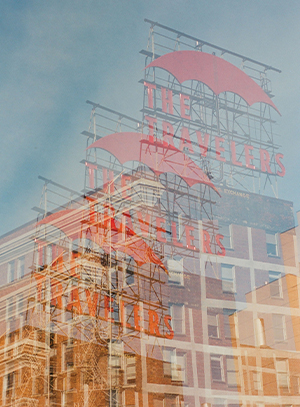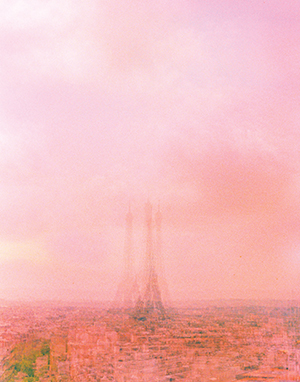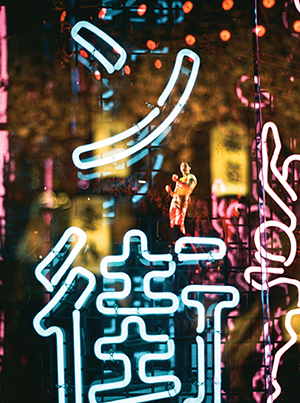Local artist Sara Johansen doused a photo of her daughter, Adeline, in “film soup” to create this colorful portrait.
Writer: Mathany Ahmed
Photos: Sara Johansen

Mix two parts boiling water, one part dish soap, a splash of vinegar, the juice of one lemon, a pinch of kosher salt and one roll of Kodak film in a large mason jar. Submerge the film for at least three hours and stir it frequently. Follow up with a cold water rinse, then run the film through the dryer five times or allow it to air-dry for up to three weeks.
This is the “film soup” recipe that local photographer Sara Johansen uses to create prints that burst with energy and color despite their rough-and-tumble development. Think of a caterpillar that liquefies in its chrysalis before emerging as a butterfly.
In one picture, leftover cranberries from Thanksgiving stain the image. In another, two different moments are combined into one, as if they happened closer together in time and space. Film soup and Johansen’s other nontraditional techniques embed in her photos memories and even physical remnants of the places they were taken.
New angles
Johansen’s love affair with photography began in 2017, when she moved to Fargo, North Dakota, with her husband, Nate, their 2-year-old daughter, Adeline, and newborn, William. At the time, she was struggling with the move, recovering from giving birth and feeling isolated from the rest of her family. “Taking pictures of my kids every day was like therapy,” she said. “Photography became a lifeline for me.”
The repetition in her early photos highlights almost imperceptible changes in the children as they got older. The only difference from one photo to another may be an inch of growth or a lost tooth. Through repetition, even the subjects beyond her immediate family magnify life’s ever-changing nature. “I can use the exact same film stock, the exact same ingredients, down to an exact measurement, and my results are going to look different,” she said.
When Johansen and her family moved to Des Moines in 2020, they discovered the Pappajohn Sculpture Park and have returned to it often for fun and inspiration. The kids run around the hills, which frees up Johansen to find creative ways to snap the familiar landmarks. Even with repeated visits, her process produces surprising results. In one shot, the “soup” tie-dyes the sky around Jaume Plensa’s “Nomade,” hinting at her son’s mood as he gazes off into the distance.
“I want to put my own spin on it,” she said. “It’s fun to see where you can take a traditional image and make it different.”

Seeing triple: Sara Johansen used multiple exposures to add a fresh twist to the familiar sign on the Des Moines skyline.
Unusual ingredients
Johansen creates her unique images through thoughtful composition, unexpected “soup” ingredients, such as ocean saltwater and even spoiled produce, and the experimental nature of film photography itself. The self-described “mad scientist” manipulates her photos with hands-on techniques that simply aren’t possible on a digital camera.
In a photo of the Eiffel Tower she took in 2023, Johansen snapped her shutter dozens of times before letting the film advance. The multiple exposures rendered the landmark hazy and intangible, in what she described as a riff on the nature of memory. “We are able to reframe things to make them different than they actually were,” she said.
“In the moment, I did not love Paris,” she said. The two-day trip was rushed and jam-packed, and she felt frazzled by the end of it. But when she got the photos back from her developer, these shots were her favorites.
Although each soup recipe is different, Johansen often uses ingredients with a connection to the photos. For the film from the European trip, she used black volcano salt from Iceland, red wine forgotten in the fridge and, at her daughter’s suggestion, basil leaves from the garden.
“I feel like I’m looking back at Paris through rose-colored glasses,” she said.

She processed a photo of the Eiffel Tower in a chemical “soup” that included red wine and black volcano salt.
Kaleidoscopic colors
The energy in Johansen’s images is a part of her unique flair. Her photos often feature people dancing, children running or wildflowers swaying in the wind.
When the subjects are stationary, Johansen uses the soup to imbue the frames with movement. In one image of Des Moines, it warps the negative space around the iconic Travelers Insurance sign. Flaming orange and lime green swirl beneath the neon umbrella. In another, water from Saylorville Lake creates splashes of color and amplifies the texture. “Bright colors make me happy,” she said. “I love capturing color and bringing out a vibrant look to things.”
The liveliness of the film-soup process contrasts with its destructiveness. Most photographers protect their film from light and moisture before it’s developed, but Johansen does the opposite. “I’ll use multiple exposures or intentional light leaks. I do a lot of Polaroid work, and sometimes I’ll deconstruct my Polaroids,” she said. “I always think, ‘Hey, let’s just see what happens.’”

Look closely: Sara Johansen’s double exposure frames a tiny shot of Harry Styles in the window of a sushi restaurant.
Beautiful imperfections
It wasn’t always so easy for Johansen to surrender control. She panicked the first time she concocted a film soup. “I was sitting there with the boiling water, and I stopped myself from pouring it over the film at least five or six times,” she said. Having a roll of unaltered film, or “straight shots,” on another camera gave her the security she needed to make the final jump, and since then, she’s made a practice of letting go.
“Ninety percent of the time, it’s not going to turn out the way you thought it would,” she said. “When it doesn’t work out for whatever reason, I accept that I wasn’t meant to have that image.”
In a photo from Las Vegas, she shot the hot pink and electric blue Japanese characters in the hallway of a sushi restaurant in late 2022. Then she removed the film from her camera, labeled the roll and tucked it away for future use. Six months later she used the same roll again at a Harry Styles concert in Los Angeles. After developing the photos, she couldn’t believe her luck: The pop star who sings “Music for a Sushi Restaurant” was perfectly framed by the neon signs she’d shot so many months before.
“We can try to do something just perfect,” she said. “But things turn out a little bit better when we allow ourselves to let go.”











